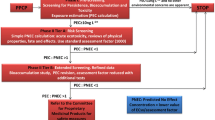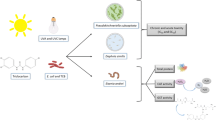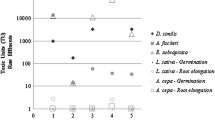Abstract
Background, aim, and scope
The high consumption of blood lipid regulators is leading to frequent reports of the occurrence of fibrates in natural streams and wastewater effluents. This paper describes a study undertaken to evaluate the acute toxicity of bezafibrate, clofibric acid, gemfibrozil, and fenofibric acid, a metabolite of fenofibrate whose ecotoxicity has not been previously reported.
Materials and methods
The bioassays used were based on Vibrio fischeri, Daphnia magna, and Anabaena CPB4337 tests. Anabaena CPB4337 is a novel bioassay based on Anabaena sp. PCC 7120 strain CPB4337 bearing in the chromosome a Tn5 derivative with luxCDABE from the luminescent terrestrial bacterium Photorhabdus luminescens.
Results
The higher toxicity corresponded to fenofibric acid, with EC50 as low as 1.72 mg/l for V. fischeri. Gemfibrozil was also toxic for Anabaena sp. with EC50 of 4.42 mg/l. The study reports the results from toxicity tests using fortified real wastewater samples taken from the effluent of a wastewater treatment plant. The wastewater itself was found to be very toxic to Anabaena CPB4337 (84% of bioluminescence inhibition) whereas it did not have any negative effect on D. magna or V. fischeri. On the contrary, V. fischeri luminescence exhibited a stimulatory effect in wastewater.
Discussion
Except for fenofibric acid, the Anabaena bioassay was more sensitive than the D. magna and V. fischeri bioassays to bezafibrate, clofibric acid, and gemfibrozil. For the three toxicity tests, fortification resulted in lower measured toxicity for the four compounds, probably indicating a reduced bioavailability due to the interaction with other chemicals in the wastewater or with particulate matter. The observed decrease in toxicity associated to the use of a wastewater matrix was higher for the more hydrophobic compounds reaching one order of magnitude for bezafibrate and gemfibrozil.
Conclusions
The Anabaena CPB4337 bioassay revealed a certain risk associated with the three less toxic compounds tested. Based on V. fischeri and D. magna bioassays, bezafibrate and gemfibrozil would have been considered non-toxic and harmful, respectively. The use of EC50 data measured in wastewater increases the risk estimation.
Recommendations and perspectives
Cyanobacteria, as primary producers with a key role in the carbon and nitrogen cycles, are a substantial component of the microbial food webs. Any detrimental effect on this group may have a negative impact in nutrient availability to organisms of higher trophic levels and should be considered in ecotoxicity assessment tests.
Similar content being viewed by others
References
Abbondanzi F, Cachada A, Campisi T, Guerra R, Raccagni M, Iacondini A (2003) Optimisation of a microbial bioassay for contaminated soil monitoring: bacterial inoculum standardisation and comparison with Microtox® assay. Chemosphere 53:889–897
Allen MB, Arnon DI (1955) Studies on nitrogen-fixing blue green algae. I Growth and nitrogen fixation by Anabaena cylindrica Lemm. Plant Physiol 30:366–372
Andreozzi R, Marotta R, Nicklas P (2003) Pharmaceuticals in STP effluents and their solar photodegradation in aquatic environment. Chemosphere 50:1319–1330
Boyd GR, Reemtsma H, Grimm DA, Mitrac S (2003) Pharmaceuticals and personal care products (PPCPs) in surface and treated waters of Louisiana, USA and Ontario, Canada. Sci Total Environ 311:135–149
Buser HR, Müller MD, Theobald N (1998) Occurrence of the pharmaceutical drug clofibric acid and the herbicide Mecoprop in various Swiss Lakes and in the North Sea. Environ Sci Technol 32:188–192
Carballa M, Omil F, Lema JM, Llompart M, García-Jares C, Rodríguez I, Gómez M, Ternes T (2004) Behavior of pharmaceuticals, cosmetics and hormones in a sewage treatment plant. Water Res 38:2918–2926
Cleuvers M (2003) Aquatic ecotoxicity of pharmaceuticals including the assessment of combination effects. Toxicol Lett 142:185–194
Comerton AM, Andrews RC, Bagley DM, Yang P (2007) Membrane adsorption of endocrine disrupting compounds and pharmaceutically active compounds. J Memb Sci 303:267–277
Commission of the European Communities (1992) Methods for determination of ecotoxicity; Annex V, C.2, Daphnia, Acute toxicity to Daphnia, L 383A, EEC Directive 92/69/EEC, pp 172–178
Commission of the European Communities (1996) Technical guidance document in support of commission directive 93/67/EEC on risk assessment for new notified substances and commission regulation (EC) no. 1488/94 on risk assessment for existing substances. Part II. Environmental risk assessment. Office for Official Publications of the European Communities, Luxembourg
Daughton CG, Ternes TA (1999) Pharmaceuticals and personal care products in the environment: agents of subtle change? Environ Health Perspect 107:907–938
Deryabin DG, Aleshina ES (2008) Effect of salts on luminescence of natural and recombinant luminescent bacterial biosensors. Appl Biochem Biotech 44:292–296
European Medicines Evaluation Agency (2006) Guideline on the environmental risk assessment of medicinal products for human use. London, Doc. Ref. EMEA/CHMP/SWP/4447/00
Fent K, Weston AA, Caminada D (2006) Ecotoxicology of human pharmaceuticals. Aquat Toxicol 76:122–159
Fernandez-Pinas F, Wolk CP (1994) Expression of luxCD-E in Anabaena sp. can replace the use of exogenous aldehyde for in vivo localization of transcription by luxAB. Gene 150:169–174
Fernandez-Pinas F, Leganes F, Wolk CP (2000) Bacterial lux genes as reporters in cyanobacteria. Methods Enzymol 305:513–527
Ferrari B, Paxéus N, Giudice R, Pollio A, Garric J (2003) Ecotoxicological impact of pharmaceuticals found in treated wastewaters: study of carbamazepine, clofibric acid, and diclofenac. Ecotox Environ Saf 55:359–370
Gagné F, Blaise C, André C (2006) Occurrence of pharmaceutical products in a municipal effluent and toxicity to rainbow trout (Oncorhynchus mykiss) hepatocytes. Ecotoxicol Environ Saf 64:329–336
Halling-Sørensen B, Nielsen BN, Lanzky PF, Ingerslev F, Lützhoft HCH, Jorgensen SE (1998) Occurrence, fate and effects of pharmaceutical substances in the environment, a review. Chemosphere 36:357–394
Han GH, Hur HG, Kim SD (2006) Ecological risk of pharmaceuticals from wastewater treatment plants in Korea: occurrence and toxicity to Daphnia magna. Environ Toxicol Chem 25:256–71
Heberer TH, Stan HJ (1997) Determination of clofibric acid and N-(phenylsulfonyl)-sarcosine in sewage, river and drinking water. Int J Environ Anal Chem 67:113–124
Henschel KP, Wenzel A, Diedrich M, Fliedner A (1997) Environmental hazard assessment of pharmaceuticals. Regul Toxicol Pharm 25:220–225
Hernando MD, Petrovic M, Fernández-Alba AR, Barceló D (2004) Analysis by liquid chromatography–electrospray ionization tandem mass spectrometry and acute toxicity evaluation for β-blockers and lipid-regulating agents in wastewater samples. J Chrom A 1046:133–140
Hernando MD, Agüera A, Fernández-Alba AR (2007) LC–MS analysis and environmental risk of lipid regulators. Anal Bioanal Chem 387:1269–1285
Huber MM, Canonica S, Park GY, von Gunten U (2003) Oxidation of pharmaceuticals during ozonation and advanced oxidation processes. Environ Sci Technol 37:1016–1024
International Organization for Standardization (2007) Water quality—determination of the inhibitory effect of water samples on the light emission of Vibrio fischeri (Luminescent bacteria test). ISO 11348-3 revised version, Geneva, Switzerland
Isidori M, Nardelli A, Pascarella L, Rubino M, Parrella A (2007) Toxic and genotoxic impact of fibrates and their photoproducts on non-target organisms. Environ Int 33:635–641
Jørgensen SE, Halling-Sørensen B (2000) Pharmaceuticals in the environment. Chemosphere 40:691–699
Kümmerer K (2001) Drugs in the environment: emission of drugs, diagnostic aids and disinfectants into wastewater by hospitals in relation to other sources—a review. Chemosphere 45:957–969
Lambropoulou DA, Hernando MD, Konstantinou IK, Thurman EM, Ferrer I, Albanis TA, Fernández-Alba AR (2008) Identification of photocatalytic degradation products of bezafibrate in TiO2 aqueous suspensions by liquid and gas chromatography. J Chrom A 1183:38–48
Lewis DFV, Lakeb BG (1998) Molecular modelling of the rat peroxisome proliferator-activated receptor -α (rPPARα) by homology with the human retinoic acid X receptor α (hRXRα) and investigation of ligand binding interactions I: QSARs. Toxicol In Vitro 12:619–632
Lin AYC, Plumlee MH, Reinhard M (2006) Natural attenuation of pharmaceuticals and alkylphenol polyethoxylate metabolites during river transport: photochemical and biological transformation. Environ Toxicol Chem 25:1458–64
Metcalfe CD, Koenig BG, Bennie DT, Servos M, Ternes TA, Hirsch R (2003a) Occurrence of neutral and acidic drugs in the effluents of Canadian sewage treatment plants. Environ Toxicol Chem 22:2872–2880
Metcalfe CD, Miao XS, Koenig BG, Struger J (2003b) Distribution of acidic and neutral drugs in surface waters near sewage treatment plants in the lower Great Lakes, Canada. Environ Toxicol Chem 22:2881–2889
Norberg-King TJ (1993) A linear interpolation method for sublethal toxicity: the inhibition concentration (ICp) approach program and user manual, version 2.0. US Environmental Protection Agency Environmental Research Laboratory, Duluth National Effluent Toxicity Assessment Center Technical Report 03-93
OECD (2008) Guidelines for the testing of chemicals, no. 23: guidance document on aquatic toxicity testing of difficult substances and mixtures, PDF Edition (ISSN 1607-310X), 18th Addendum
Packer JL, Werner JJ, Latch DE, McNeill K, Arnold WA (2003) Photochemical fate of pharmaceuticals in the environment: naproxen, diclofenac, clofibric acid, and ibuprofen. Aquat Sci 65:342–351
Rodríguez A, Rosal R, Perdigón JA, Mezcua M, Agüera A, Hernando MD, Letón P, Fernández-Alba AR, García-Calvo E (2008) Ozone-based technologies in water and wastewater treatment. In: Barceló D, Petrovic M (eds) Emerging contaminants from industrial and municipal waste (The Handbook of Environmental Chemistry). Springer, Berlin, pp 127–175
Rosal R, Rodríguez A, Perdigón-Melón JA, Mezcua M, Agüera A, Hernando MD, Letón P, García-Calvo E, Fernández-Alba AR (2008) Removal of pharmaceuticals and kinetics of mineralization by O3/H2O2 in a biotreated municipal wastewater. Water Res 42:3719–3728
Sanderson H, Johnson DJ, Wilson CJ, Brain RA, Solomon KR (2003) Probabilistic hazard assessment of environmentally occurring pharmaceuticals toxicity to fish, daphnids and algae by ECOSAR screening. Toxicol Lett 144:383–395
Schabenberger O, Tharp BE, Kells JJ, Penner D (1999) Statistical tests for hormesis and effective dosages in herbicide dose response. Agron J 91:713–721
Scheytt T, Mersmann P, Lindstädt R, Heberer T (2005) 1-Octanol/water partition coefficients of 5 pharmaceuticals from human medical care: carbamazepine, clofibric acid, diclofenac, ibuprofen, and propyphenazone. Water Air Soil Poll 165:3–11
Seco JI, Fernández-Pereira C, Vale J (2003) A study of the leachate toxicity of metal-containing solid wastes using Daphnia magna. Ecotoxicol Environ Saf 56:339–350
Southman CM, Ehrlich J (1943) Effects of extract of western red-cedar hardwoods on certain wood-decaying fungi in culture. Phytopathology 33:517–524
Stumpf M, Ternes TA, Wilken RD, Rodrigues SV, Baumann W (1999) Polar drug residues in sewage and natural waters in the state of Rio de Janeiro, Brazil. Sci Total Environ 225:135–141
Szittner R, Meighen E (1990) Nucleotide sequence, expression, and properties of luciferase coded by lux genes from a terrestrial bacterium. J Biol Chem 265:16581–16587
Tauxe-Wuersch A, De Alencastro LF, Grandjean D, Tarradellas J (2005) Occurrence of several acidic drugs in sewage treatment plants in Switzerland and risk assessment. Water Res 39:1761–1772
Ternes TA (1998) Occurrence of drugs in German sewage treatment plants and rivers. Water Res 32:3245–60
USEPA (1994) Short-term methods for estimating the chronic toxicity of effluents and receiving waters to freshwater organisms, 3rd edn. US Environmental Protection Agency, Cincinnati EPA/600/4-91/002
USEPA (2002) Methods for measuring the acute toxicity of effluents and receiving waters to freshwater and marine organisms, 5th edn. US Environmental Protection Agency, Washington DC EPA-812-R02-012
Weigel S, Kuhlmann J, Hühnerfuss H (2002) Drugs and personal care products as ubiquitous pollutants: occurrence and distribution of clofibric acid, caffeine and DEET in the North Sea. Sci Total Environ 295:131–141
Zurita JL, Repetto G, Jos A, Salguero M, López-Artíguez M, Camean AM (2007) Toxicological effects of the lipid regulator gemfibrozil in four aquatic systems. Aquat Tox 81:106–115
Acknowledgements
The research was funded by the Spanish Ministry of Education through grants CTM2005-03080/TECNO and CSD2006-00044 and the Comunidad de Madrid, grants 0505/AMB-0395 and 0505/MB/0321.
Author information
Authors and Affiliations
Corresponding author
Additional information
Responsible editor: Christian Steinberg
Rights and permissions
About this article
Cite this article
Rosal, R., Rodea-Palomares, I., Boltes, K. et al. Ecotoxicity assessment of lipid regulators in water and biologically treated wastewater using three aquatic organisms. Environ Sci Pollut Res 17, 135–144 (2010). https://doi.org/10.1007/s11356-009-0137-1
Received:
Accepted:
Published:
Issue Date:
DOI: https://doi.org/10.1007/s11356-009-0137-1




